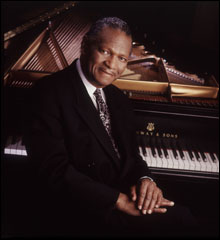Tyner, Coltrane, Kenny Garrett, and Branford Marsalis
By JON GARELICK | September 26, 2006

THE TOUCH: Like Coltrane, Tyner, besides having speed and power, has always had something else. |
“I’m playing changes!” That’s what a young jazz-pianist acquaintance of mine announced exultantly to one of his musical buddies back in the early ’70s.It was a funny thing to say. Jazz musicians cut their teeth on changes, the chord progressions that underlie the structure of every tune. So the young pianist was supposed to be playing changes. The reason he hadn’t been can be attributed to one man: McCoy Tyner.
Or maybe two, the other being John Coltrane. Coltrane’s quartet of 1960-’65 with Tyner, bassist Jimmy Garrison, and drummer Elvin Jones is considered the most influential band in the history of jazz. And together they helped make modal jazz central to the mainstream. Rather than playing “changes,” the band would play modal scales over a single chord for . . . as long as they wanted. As the saying goes, not everything in a piece of music can be complicated. You can play complex rhythms, complex melodies, complex harmonies — but not all at once, or the density of the piece becomes impenetrable.
The Coltrane Quartet pushed the idea of playing extended complex scalar patterns over ever-increasing free rhythms and a simple, grounding drone figure. It was Tyner’s job to state that grounding drone in his left hand with alternating sevenths and 10ths the way a sarod establishes the underlying drone of Indian music.
Part of what was attractive to young musicians following in the Coltrane Quartet’s wake was that with such a procedure you could play just about any melodic pattern and have it be correct, or at least not wrong. But correct isn’t always interesting. So for every Joe Farrell or Dave Liebman or Michael Brecker — saxophonists who were able to create their own identities within the sphere of Coltrane’s influence — there were scores of reedmen who sounded like verbose imitators, spinning their wheels on exercise-book patterns. And aside from Joanne Brackeen, most Tyner stylists of the era are lost to memory. Modal jazz may be easier to learn how to play, but it’s not easy to make interesting — and there are no shortcuts to Coltrane’s singular spiritual intensity.
One thing we’ve learned is that it isn’t just a matter of loud and fast, either. Like Coltrane, Tyner (who comes to the Berklee Performance Center this Saturday with a septet as part of the BeanTown Jazz Festival) has always had something else. He’s always had the rumbling power and lightning finger speed to hold his own with drummers as dynamic as Jones and a tenor as big as Coltrane. But Tyner also has that one indefinable thing that not many jazz pianists have: touch. A piano just sounds different when he plays it, no matter what the individual notes or chords. From the very first chord, the piano sounds like a Tyner piano in a way that has nothing to do with power or volume. In his own way, his touch is as distinctive as Hank Jones’s. Coltrane attributed Tyner’s sound to his particular voicings of chords and clusters — something that made even familiar chord progressions sound distinctive.
 Related
Related:
An old lion roars, Personal code, Holy spirit of the saxophone, More 
- An old lion roars
In recent years, McCoy Tyner has looked frail for his age — once robust and round-faced, he now appears gaunt.
- Personal code
The connection between jazz and India is at least as old as John Coltrane’s composition named for that country.
- Holy spirit of the saxophone
John Coltrane died 40 years ago this past July at the age of 40 of liver cancer.
- Mining the past
John Coltrane acid blasts rage through the Mars Volta’s new The Bedlam in Goliath.
- Permanent shuffle
Every year the box sets reshuffle jazz history.
- The long view
Bob Blumenthal’s first book is out, and the wonder is that we didn’t get it sooner.
- The talk of the town
With the Boston Globe Jazz & Blues Festival defunct and no other significant local jazz fest in sight, the Beantown Jazz Festival has been stepping up to fill the void.
- Getting it live
Noah Preminger — bearded, shaggy-haired, 23 years old — plays tenor saxophone like a man at least twice his age while remaining completely of the moment.
- In action
In the era of YouTube, we’re apt to forget that not every note of music ever played has been captured on film or video.
- Seven layers of heaven
Working on the fly, the organizers created an odd layer cake.
- Budding groves
More and more, museums are getting into the live-music scene.
- Less

 Topics
Topics:
Jazz
, Entertainment, Eric Revis, Pharoah Sanders, More  , Entertainment, Eric Revis, Pharoah Sanders, Art Tatum, Ashley Kahn, Dave Liebman, Joanne Brackeen, Joe Farrell, Smooth Jazz, Music, Less
, Entertainment, Eric Revis, Pharoah Sanders, Art Tatum, Ashley Kahn, Dave Liebman, Joanne Brackeen, Joe Farrell, Smooth Jazz, Music, Less 